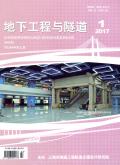The construction of the tunnel Kennedy in Santiago de Chile. A major challenge of an urban tunnel in soils
引用次数: 0
Abstract
Costanera Norte is an urban expressway concessionary in Santiago de Chile connecting its Western and Eastern sides. To enhance this connectivity several measures were necessary, including four new tunnels. The most singular one is 'Tunnel Kennedy', that has a length of 1,166 m with two sections (4 and 5 lanes), 17.45m and 20.95m wide, and 11.8m height. The tunnel was excavated in alluvial gravels, partially under the water table. The main challenges were: its section over 250m 2 , the ground conditions (requiring SEM), its urban environment and low overburden (10 to 16m). The support consists in a 3cm sealing, HEB steel arches spaced 1.0m and 27cm shotcrete. Systematically buttress and occasional canopy tubes have been used. A concrete lining (20cm to 40 cm, depending on the water column), was added, and a third layer 10cm with polypropylene fibers for fire protection. The excavation took place from October 2014 to February, 2017. The typical cross section of the tunnel provides four lanes, 3.5 m wide each one, and two shoulders of 0.75 m respectively. Below the pavement a maintenance gallery is provided. The inner dimensions with respect to the lining are 17.45 m wide and 11.30 m height. At the beginning of the tunnel, there is a connection lane so for around 50 m, a special section of five lanes have been constructed. For this section, the inner dimensions are 21.0 m width and 11.8 m height. An additional section was also envisaged, which was called “4.5 lanes”, designed in order to soften the transition between the sections of five and four lanes. Figure 2 shows the geometrical definition of the two existing sections of the tunnel. Figure 2. Functional sections (4-lanes and 5-lanes). Kennedy Tunnel. As mentioned before, three emergency exits have been constructed for the evacuation plan of the tunnel. The first one is located close to the access structures at the portal. The second and third ones were solved by shafts of 8,3 m diameter from surface and pedestrian gallery connections. 2 GEOLOGICAL AND GEOTECHNICAL CHARACTERISTICS The entire tunnel has been excavated in the well-known alluvial materials composed by gravels and pebbles of the second and first deposition of the Mapocho River. In the lower part of the tunnel, the presence of weathered andesites and lutites of Abanico Formation, was expected between Km 1,046 and Km 1,050 in the invert of the tunnel section. However, just some andesite blocks have been excavated In terms of the soil parameters, Table 1 shows strength and deformational parameters considered for the support calculations. Table 1 Strength and deformational parameters of the soil in the Kennedy Tunnel. SOIL PARAMETERS GEOTECHNICAL UNIT ANTHROPIC FILL 2nd DEPOSITION 1st DEPOSITION γ (kN/m 3 ) 17,0 22,5 22,5 Cmax (kPa) 10 25 35 φm (°) 33 45 48 Ec (kPa) 20.000 42.000xZ0,5(Z<17) 42.000xZ0,55(Z<17) (*) 55.000xZ0,53(Z>17) v 0,30 0,25 0,25 Ψ (°) 0 12 12 K0 0,43 0,70 0,9-0,0533X(Z-6)(6智利圣地亚哥肯尼迪隧道的建设。城市隧道在土壤中的主要挑战
Costanera Norte是智利圣地亚哥的城市高速公路特许经营权,连接其西部和东部。为了加强这种连通性,需要采取一些措施,包括四条新隧道。最奇特的是“肯尼迪隧道”,全长1166米,分为4车道和5车道两部分,宽17.45米和20.95米,高11.8米。隧道是在冲积砾石中开挖的,部分位于地下水位以下。主要的挑战是:它的剖面超过250米2,地面条件(需要SEM),城市环境和低覆盖层(10到16米)。支撑由3cm的密封、间隔1.0m的HEB钢拱和27cm的喷射混凝土组成。系统地支撑和偶尔的冠管被使用。添加了混凝土衬里(20厘米至40厘米,取决于水柱),并添加了第三层10cm的聚丙烯纤维用于防火。挖掘工作于2014年10月至2017年2月进行。隧道典型断面设4条车道,每条车道宽3.5米,两条车道肩宽分别为0.75米。在路面下方设有维修廊。衬砌的内部尺寸为17.45米宽,11.30米高。在隧道的开始,有一条连接车道,因此在大约50米的地方,一个由5条车道组成的特殊路段已经建成。本剖面的内部尺寸为宽21.0 m,高11.8 m。还设想了一个额外的路段,称为“4.5车道”,旨在软化五车道和四车道路段之间的过渡。图2显示了隧道现有两段的几何轮廓。图2。功能部分(4车道和5车道)。肯尼迪隧道。如前所述,为了隧道的疏散计划,已经建造了三个紧急出口。第一个靠近入口的入口结构。第二个和第三个是通过与地面和行人通道连接的直径8,3米的竖井来解决的。2地质与岩土工程特点整个隧道是在著名的由马波乔河第二次和第一次沉积的砾石和鹅卵石组成的冲积物中开挖的。在隧道的下部,预计在1046公里至1050公里的隧道断面倒转处,存在阿巴尼科组的风化安山岩和水晶石。在土体参数方面,支护计算中考虑的强度和变形参数如表1所示。表1甘迺迪隧道土体强度及变形参数。土工单位人为填土第二次沉积第一次沉积γ (kN/m 3) 17,0,22,5,22,5 Cmax (kPa) 10 25 35 φm(°)33 45 48 Ec (kPa) 20.000 42.000 xz0,5 (Z17) v 0,30,250,25 Ψ(°)0 12 12 K0 0,43,70,9 -0,0533 x (Z-6)(6
本文章由计算机程序翻译,如有差异,请以英文原文为准。
求助全文
约1分钟内获得全文
求助全文
联系我们:info@booksci.cn
Book学术提供免费学术资源搜索服务,方便国内外学者检索中英文文献。致力于提供最便捷和优质的服务体验。
Copyright © 2023 布克学术 All rights reserved.
京ICP备2023020795号-1
 京公网安备 11010802042870号
京公网安备 11010802042870号
京ICP备2023020795号-1

Book学术文献互助群
群 号:604180095


 求助内容:
求助内容: 应助结果提醒方式:
应助结果提醒方式:
